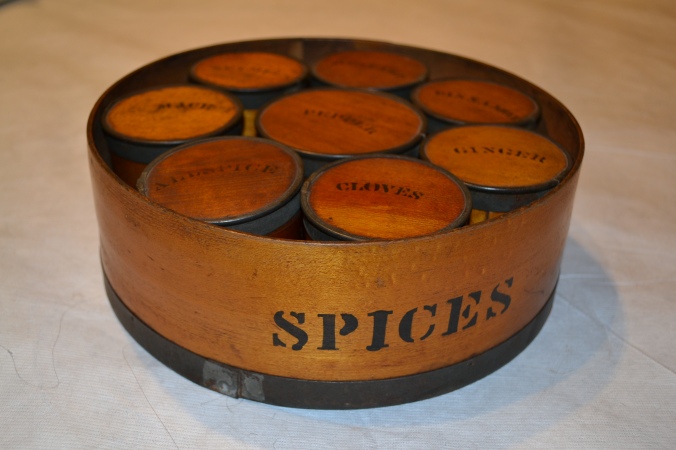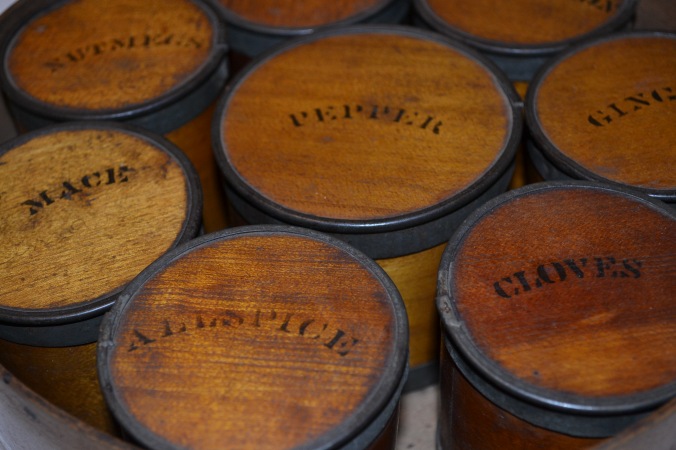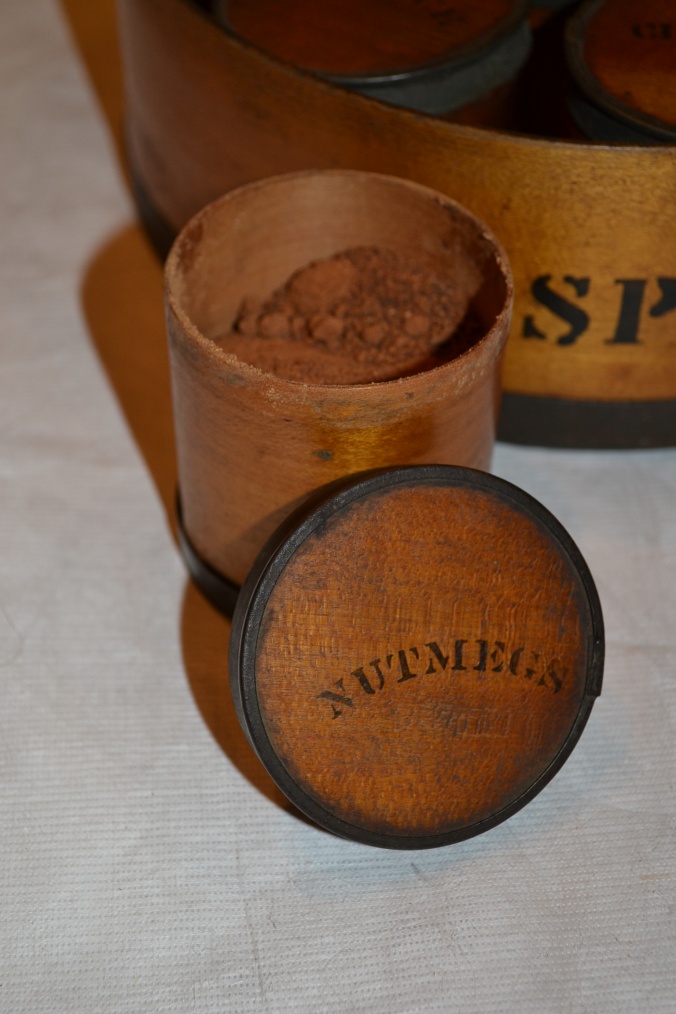By Jillian Heller
At Historic Huguenot Street, we have a large collection of kitchen items. One object that we have is a late 19th century wooden circular box containing several spice jars. Today, we have our own updated and condensed versions of these spice holders in our cabinets and drawers at home. However, spices have a history much richer than from the 1800s to now. Spices can be dated back to the 3rd millennium B.C. and had uses far beyond cooking. In fact, the demand for spices had been so intense that it led to great things like power, wealth, and colonization. We owe a lot more of our presence in the United States than we realize to the significance of spices.
Our object of the week is a round polished wooden container with a metal band on the bottom and a lid on top. Along the side of the vessel is the label “SPICES”. Once opened, one is overwhelmed with a beautiful historic aroma. Immediately, the various seasonings fill your lungs and it transports you to inside the kitchen of the Jean Hasbrouck House. Inside the box, there are eight spice jars. These are also round and wooden with metal bands at the top and bottom with lids, in the same style of the container. The center spice jar is larger than the rest and placed in the center, labeled “PEPPER.” The other spices are mace, all spice, cloves, ginger, cinnamon, mustard, and nutmeg. These smaller jars are placed in a circular surrounding the pepper.



We have similar, more modern collections of the same spices in all of our kitchens today. This 19th century spice holder can exemplify how continuous spices have been of common use in North America. However, the use of spices goes back extremely further to about 3500 B.C. in Ancient Egypt. Through archaeological evidence and what we know today, spices have been essential in shaping the modern world.
Throughout history, spices have been very valuable items that could be used in various ways. They did much more than flavor foods, as opposed to what we mostly use them for today. All around the world, spices were implemented in numerous practices and over thousands of years.
Since spices were so useful, they were always in demand. Therefore, there was a huge market for trading spices. From Ancient Egypt, to Asia, to Mesopotamia, to Europe, spices spread globally. Around 2000 B.C. spices were controlled and monopolized by the Arabs. Merchants caravanned by donkeys and camels throughout the Middle East and South Asia. Spices were so valued that large amounts of gold and silver were traded to obtain them. After the first century, Rome disturbed the Arab monopoly and established a direct trade with India via the Red Sea. From here, spices exploded even more. Once the Romans had a constant source, Europe could not get enough of it. From the 18th until the 15th century, the trade relation made Italian city-states rich. An estimated over 2,000 tons of spices were imported to Western Europe yearly during the late Middle Ages.
Not surprisingly, other European countries wanted to find their own sources for spices and pay less money. This could only be accomplished by exploring the waters and hopefully finding a new place of export. In 1492, Christopher Columbus, with the support of Spain, set out to search for a shorter water route for black pepper and cinnamon. He intended to arrive in Japan to establish a new trade route, however, he landed in the Bahamas archipelago named “San Salvador.” This is how the New World was exposed to the Europeans. In turn, Columbus’s contact with the Americas forever changed the course of Modern history. He continued to return with four voyages in total. These trips signified the beginning of European Exploration and the start of the colonization of the Americas. In the next two hundred years, colonies spread throughout the western hemisphere, particularly in North America by the French, Dutch, and English. These settlements evolved and gave way to the American frontier.
Although a long and far journey, it is evident that the importance of spices led to the settling of the New World and is a large reason modern day America exists. The need for spices stemmed from its abundant set of uses. The huge demand crazed the old world over trade and wealth. It is difficult to imagine when the New World would have been colonized if Columbus never searched for new spice routes. This is why it was hard for me to overlook the wooden circular spice container in our collection here at Historic Huguenot Street. These 19th century seasonings provide insight for understanding our origins. It is incredible to think that something we use everyday on our food, has been such a constant throughout our world history.
Resources:
“HISTORY OF SPICE TRADE.” Medicinal Spices Exhibit – UCLA Biomedical Library: History & Special Collections. UCLA, n.d. Web. 28 Oct. 2015.
“History of Spices.” McCormick Science Institute. McCormick Science Institute, n.d. Web. 28 Oct. 2015.
Sánchez, Elsa S., and Kathleen M. Kelley. “Herb and Spice History.” Home Lawn and Garden (Penn State Extension). Penn State University, n.d. Web. 28 Oct. 2015.
Whipps, Heather. “How the Spice Trade Changed the World.” LiveScience. TechMedia Network, 12 May 2008. Web. 28 Oct. 2015.